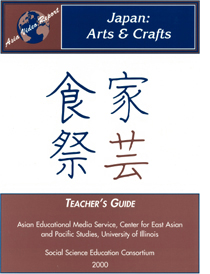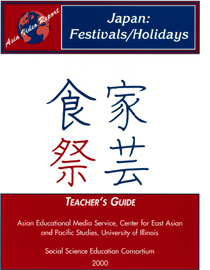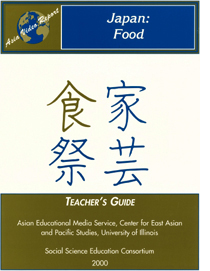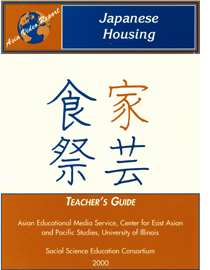Each Asia Video Report DVD has an
accompanying teacher's guide with readings, lesson plans and classroom
activities, and Internet resources (suitable for K-12). Please download the teacher's guides here in PDF format. To purchase the videos that these guides are designed for (or to watch video clips) visit the homepage for the Asia Video Reports Series for more details.
Teacher's Guides contain the following:
- Background readings
- Video stories and transcripts
- Learning activities
- Extension and enrichment
- World wide web resources

|
Japan: Arts and Crafts Teacher's Guide
(Download:  PDF) PDF)
Through this module, students will identify several Japanese art forms, describe the skills, training, tools and techniques used in creating these objects, discuss the underlying beliefs revealed in the creation of these objects, discuss ways these assumptions might be exhibited in other aspects of Japanese life, and create hypotheses about Japanese definitions of creativity and artistic talent. Module themes include: tradition and change, arts as reflection of cultural values, and transmission of culture from generation to generation.
|

|
Japan: Festivals and Holidays
Teacher's Guide
(Download:  PDF) PDF)
Students will describe events which take place during different holidays; identify aspects of the celebrations which are traditional and others which appear more recent in their origins; draw comparisons with
American celebrations which are familiar to them; analyze the psychological effects of participating in a festival; and create and discuss hypotheses about why some festivals, holidays, and celebrations take root in countries other than where they originated. Themes include: tradition and change, festivals and holidays as a reflection of cultural values, and transmission of culture from one country to another.
|

|
Food: Reflections of Japanese
Culture
Teacher's Guide
(Download:  PDF) PDF)
Students will identify several types of traditional and contemporary cuisine; explain how different types of Japanese cuisine reflect aspects of Japan's history, geography, cultural values, and international influence; and analyze two types of fast food (pizza and instant ramen) as examples of cultural transmission and global connections. Themes include: tradition and change, food as a reflection of cultural values, cultural transmission, borrowing and adapting, and global systems and connections.
|

|
Japanese Housing: Customs
in Transition
Teacher's Guide
(Download  PDF) PDF)
Through this module, students will identify their preconceptions of Japanese housing and the sources for their information; describe several traditional and innovative features in contemporary Japanese homes and appreciate the value placed on each of these features; analyze the relationship among geography, environment, housing, and lifestyle; consider how pressures on living space have influenced Japanese lifestyles and defined social issues; and solve hypothetical problems involving space and living conditions. Themes include: tradition and change, home design as a reflection of aesthetic and cultural values and geographic and environmental influences and socioeconomic realities, and cultural transmission, borrowing and adapting.
|
Last updated January 12, 2009

